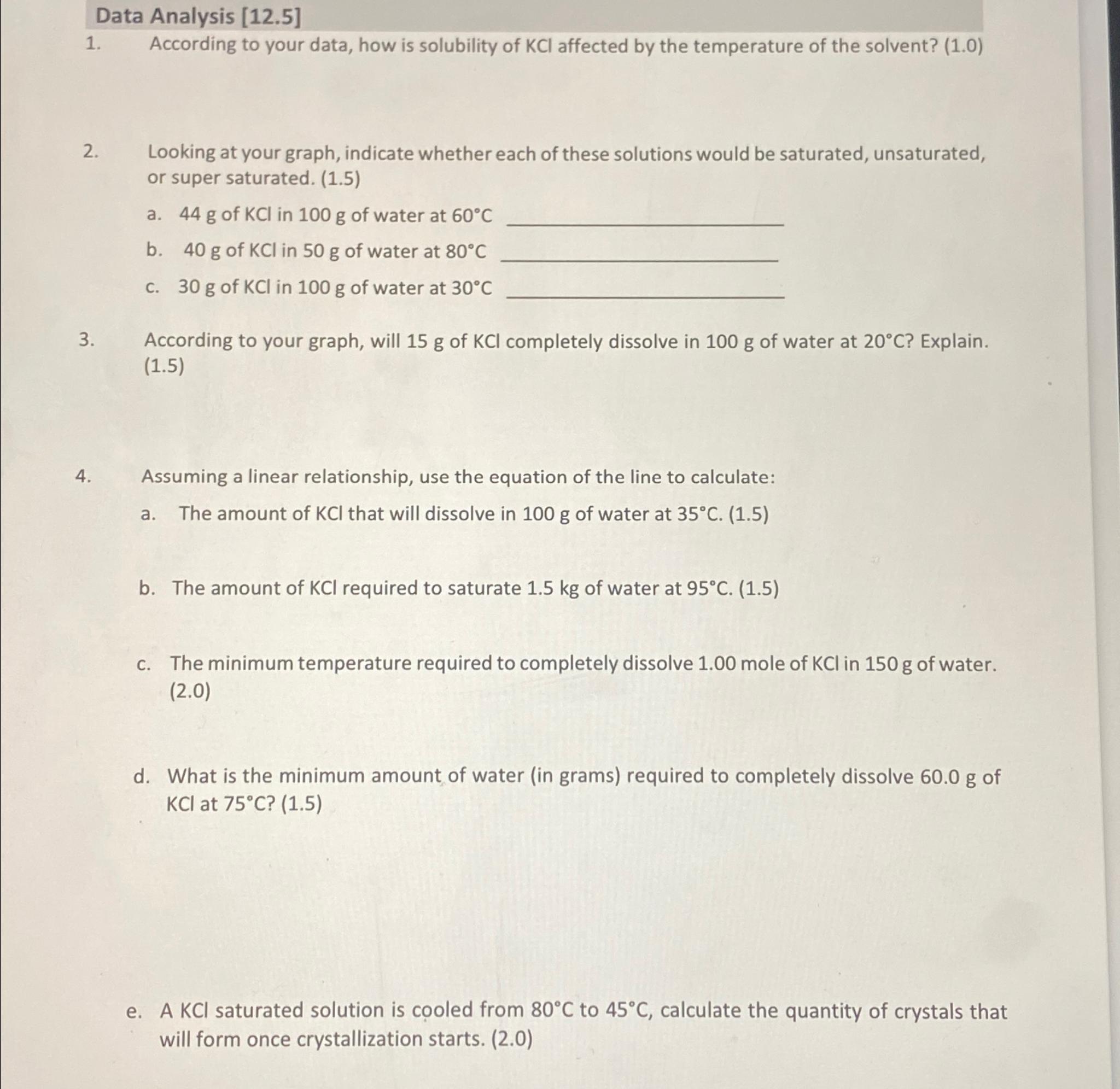Answered step by step
Verified Expert Solution
Question
1 Approved Answer
CHEM 1 1 0 3 Winter 2 0 2 4 Experiment 1 EXPERIMENT 1 An Introduction to Data Collection: The Solubility of a Salt Objectives
CHEM Winter
Experiment
EXPERIMENT
An Introduction to Data Collection: The Solubility of a Salt
Objectives
Become familiar with data collection and analysis using a temperature probe and LabQuest data collection software.
Collect the experimental data necessary to construct a solubility curve for potassium chloride in water.
Background
Solubility is an important physical property in chemistry which describes the amount of solute that dissolves in a given amount of solvent. The solubility of chemical compounds varies extremely and can be affected by factors such as pressure, temperature, and intermolecular forces or interionic forces in both the solute and the solvent. For most ionic compounds, solubility varies directly with temperature, thus, solubility is often expressed as the mass of solute that dissolves in of water at a particular temperature.
A saturated solution is a solution that contains the maximum amount of dissolved solute at a given temperature. In this type of solution dissolution and precipitation are occurring at the same rate, thereby satisfying the requirement for a dynamic equilibrium. Two statements can be made about this solution: the two processes, dissolution, and precipitation, are going on at the same time, and the number of molecules or ions in the solution remains constant. For example, the equilibrium of sodium chloride with its ions in a saturated solution would be shown by the equation
NaCl
An unsaturated solution contains less solute than does a saturated solution, ie no equilibrium is present. When additional solute is added to an unsaturated solution, it dissolves. When additional solute is added to a saturated solution, the amount of dissolved solute does not increase, because the limit of solubility has already been reached. A super saturated solution contains more than the maximum amount of dissolved solute than a saturated solution under the same conditions. Since solubility often varies with temperature a solution that is saturated at one temperature may be unsaturated at a different temperature. As well, temperature changes may cause a saturated solution to become super saturated.
In this experiment, you will collect data using temperature probe and LabQuest interface to investigate the effect of changing temperature on the amount of potassium chloride that will dissolve in a given amount of water. You will completely dissolve different known quantities of in the same volume of water at a high temperature. As each solution cools, you will monitor temperature and record the precise temperature at which solid crystals start to form. At this moment, the solution is saturated and contains the maximum amount of solute at that temperature. Each data pair consists of a solubility value of solute per and a corresponding temperature. A graph of the temperaturesolubility data, known as a solubility curve, can be obtained. Solubility curves are used to predict the mass of solute in water at any given temperature. Typical solubility curves are shown in Figure Here solid lines represent saturated solutions. Unsaturated solutions exist below the solid
of
line, whereas super saturated solutions exist above the solid line.
Figure Typical Solubility Curves
Glassware & Equipment
Balance
Beakers: &
Graduated cylinder:
Hot plate
Retort stand
Stirring rod
Test tubes:
Test tube rack
Utility clamps
Vernier LabQuest interface
Vernier Temperature probe
Weighing funnel and spatula
Chemicals
Potassium chloride KCl
Procedure
Poweron the LabQuest unit top left power button The LabQuest App launches automatically. Connect a temperature probe to the port. The LabQuest App will autoID the connected sensor and a live reading will appear in the Meter screen.
Set up the datacollection mode: On the Meter screen, tap Mode. Change the mode to Events with Entry. Enter the Name Solubility and Units gg Select OK
Fill a beaker threefourths full of tap water. Place it on a hot plate situated on or next to the base of a retort stand watch for hot plate power cord not to touch the hot surface Heat the water bath to about and adjust the heat to maintain the water at this temperature. Place the temperature probe in the water bath to monitor the temperature and to warm the probe. To keep from damaging the temperature probe wire, hang it over another utility clamp pointing away from the hot plate, as shown in Figure

Step by Step Solution
There are 3 Steps involved in it
Step: 1

Get Instant Access to Expert-Tailored Solutions
See step-by-step solutions with expert insights and AI powered tools for academic success
Step: 2

Step: 3

Ace Your Homework with AI
Get the answers you need in no time with our AI-driven, step-by-step assistance
Get Started


